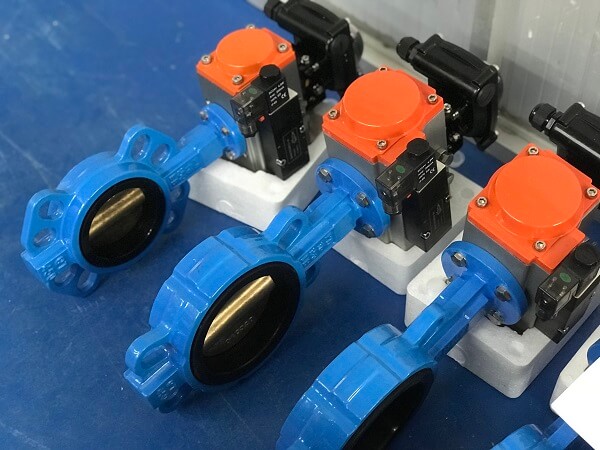The rotary center of the disc (The center of the stem) is located on the centerline of the valve body and the sealing section of the disc. Seat synthetic rubber. When closed, the outer sealing surface of the disc squeezes the synthetic rubber seat, causing the seat to deform elastically, thus forming an elastic force that acts as a sealing specific pressure to ensure the sealing of the butterfly valve. The flanged butterfly valve features a polytetrafluoroethylene, synthetic rubber compound seat that is still provided by the synthetic rubber and takes advantage of the polytetrafluoroethylene’s low coefficient of friction, resistance to wear, and resistance to aging so that the life of the butterfly valve can be improved.
The sealing principle and structure characteristics of the flange butterfly valve are the same as those of the ordinary medium line butterfly valve.
The flanged butterfly seal features a polytetrafluoroethylene, synthetic rubber, and Phenol formaldehyde resin composite seat for a resilient and strong seat. At the same time, the butterfly plate is fully covered with polytetrafluoroethylene, so that the butterfly plate has strong corrosion resistance.
1. Flange butterfly valve installation before the inspection of pneumatic butterfly valve parts are missing, model no error, check the body without debris, solenoid valve and muffler without obstruction.
2. Leave the valve and cylinder closed.
3. Bump the cylinder against the valve (installation can be parallel to or perpendicular to the body) and see if the screw holes are aligned so that there is not too much deviation. If there is a small deviation, turn the cylinder block a bit and then tighten the screws.
4. After installation, the pneumatic butterfly valve is debugged (normal air supply pressure is 0.4 ~ 0.6 MPA) , and the solenoid valve must be opened and closed manually during commissioning (manual operation can be effective only after losing power to the solenoid valve coil) observe the opening and closing of pneumatic butterfly valve. If during commissioning and operation the valve is found to be a little laborious at the beginning of the opening and closing process, and then is normal, the stroke of the cylinder needs to be reduced (adjusting the stroke adjustment screws at both ends of the cylinder a little bit at the same time, adjusting the valve to the open position, then turn off the air supply and adjust again) until the valve opens and closes smoothly and without leakage. Also note that the adjustable silencer can adjust the valve opening and closing speed, but not too small, or may cause the valve not to move.
5. Hair should be kept dry before installation and should not be stored in the open air.
6. Before installing the butterfly valve to check the pipeline, ensure that there is no welding slag and other foreign bodies in the pipeline.
7. Butterfly valve body manual opening and closing resistance moderate, butterfly valve torque and selected actuator torque match.
8. Butterfly Valve flange connection with the correct specifications, pipe clamp flange and butterfly valve flange standards. It is recommended to use butterfly Valve special flanges. Flat welding flanges are not allowed.
9. The installed pipe flange to be aligned, and placed with the Butterfly Valve in alignment.
10. Install all flange bolts and tighten by hand to make sure the butterfly valve is aligned with farlane’s, then carefully open and close the butterfly valve to ensure flexible opening and closing.
11. Fully open the valve, wrench in accordance with the diagonal order to tighten the bolts, without washers, do not tighten the bolts to prevent serious deformation of the valve ring, opening and closing torque is too large.
Post time: Jul-28-2021





